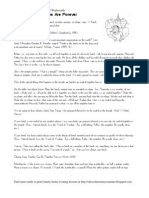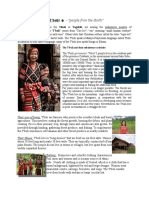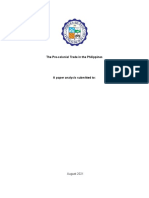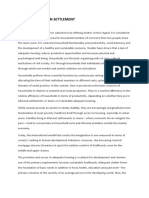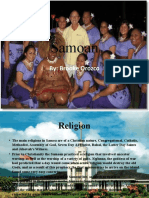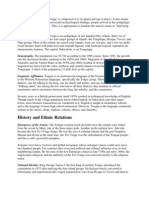Identification
Identification
Uploaded by
Sammy Thomas StephenCopyright:
Available Formats
Identification
Identification
Uploaded by
Sammy Thomas StephenCopyright
Available Formats
Share this document
Did you find this document useful?
Is this content inappropriate?
Copyright:
Available Formats
Identification
Identification
Uploaded by
Sammy Thomas StephenCopyright:
Available Formats
Identification. The name "Tonga" is composed of to (to plant) and nga (a place). It also means "south.
" According to the most recent archaeological findings, people arrived in the archipelago from Fiji around 1500 B.C.E. Thus, it is appropriate to translate the nation's name as "land lying in the south." Location and Geography. Tonga is an archipelago of one hundred fifty islands, thirty-six of which are inhabited. There are four major groups of islands: the Tongatapu, Ha'apai, Vava'u, and Niua groups. Most of the islands are raised coral islands, some are volcanic, and a few are atolls. Coral beaches lined with palm trees and emerald lagoons with luxuriant tropical vegetation are characteristic features. The capital, Nuku'alofa, is on Tongatapu. Demography. The population was 97,784 according to the 1996 census. Since 1891, the growth rate has increased steadily, peaking in the 1950s and 1960s. Migration to New Zealand, Australia, and the United States in the 1970s and 1980s resulted in slower growth. Internal migration has been from the outer, northern, and central islands toward the southern island of Tongatapu. A third of the population (31,404) lives in the capital. Linguistic Affiliation. Tongan is an Austronesian language of the Oceanic subgroup. It belongs to the Western Polynesian languages, specifically the Tongic group. There are three social dialects: one for talking to the king, one for chiefs and nobles, and one for the common people. "Talking chiefs" are among the few who know all three dialects; they mediate in official ceremonies and in encounters between the king, the nobility, and the commoners. Seventy years as a British protectorate (until 1970) resulted in widespread knowledge of English. Though much of the village population knows little English, in Nuku'alofa and other major towns, most business transactions are conducted in it. English is taught in elementary schools and is the language of most high school instruction. However, Tongan is the language commonly spoken in the streets, shops, markets, schools, offices, and churches.
History and Ethnic Relations
Emergence of the Nation. The Tongan creation myth describes how the islands were fished from the ocean by Maui, one of the three major gods. Another myth explains how 'Aho'eitu became the first Tu'i Tonga (king). He was the son of a human female and the god Tangaloa. Human and divine at the same time, the Tu'i Tonga was the embodiment of the Tongan people, and this is still a powerful metaphor. Tongans were fierce warriors and skilled navigators whose outrigger canoes could carry up to two hundred people. For centuries they exercised political and cultural influence over several neighboring islands. By the time of the first European contact in late 1700s and early 1800s, the empire had collapsed, and the authority of the Tu'i Tonga was restricted mostly to the religious realm. National Identity. King George Tupou I, the first king of modern Tonga, introduced the constitution in 1875 after unifying the four island groups. He had previously converted to Christianity and opportunistically waged expansionist wars from Ha'apai to Vava'u and then to
Tongatapu. Christian principles characterize the constitution, which very likely was prepared under the influence of Wesleyan missionaries. George Tupou I transformed Tonga into a modern state, abolishing slavery and the absolute power of chiefs. Since the last Tu'i Tonga had no official heir, as the head of the other two royal lines, King George became the only king of Tonga. The 1875 constitution recognizes only his royal line. In 1900, the British granted Tonga's request for protectorate status. In 1970, all powers were restored to the Tongan monarchy. The British protectorate shielded Tonga from other colonizing powers. A spirit of independence and pride was nurtured during the long reign of Queen Salote (19181965), who led the nation into the twentieth century, paying special attention to preserving its heritage. Because of her vision, Tongan culture is an integral part of the school curriculum. Students learn Tongan history, traditional poetry, music, and dancing, along with wood carving, mat weaving, and bark cloth making.
Urbanism, Architecture, and the Use of Space
The first European visitors spoke of a population scattered throughout a densely cultivated land. Now Tongans are concentrated in villages and small towns. Most villages lie around an empty area, called mala'e , that is used for social gatherings and games. A traditional house stands on a raised platform of stones and sand. It is oval in shape with a thatched roof and walls of woven palm tree panels. The toilet and the kitchen are in separate huts. Contemporary houses are usually bigger and made of timber with corrugated iron roofs. Little furniture is used. The simplicity of house architecture contrasts with the monumentality of earlier royal buildings and tombs. The royal tombs are layered pyramidal structures built of massive stone slabs. The huge Ha'amonga trilithon, made of two stone columns topped with a notched column, was built around 1200 C.E. One hypothesis suggests that it was the door to the royal compound, and another that it was used for astronomical purposes. These monuments bear witness to the power of the Tu'i Tonga. They also indicate the sophisticated stone-cutting technology and skills of the ancient craftsmen.
Food and Economy
Food in Daily Life. Both in villages and in the main towns, food is the occasion for a family gathering only at the end of the day. Otherwise, food is consumed freely at any time. The basic staples are root crops like taro accompanied by fried or roasted meat or fish. Taro leaves are one of the various green vegetables used together with a variety of tropical fruits like bananas, pineapples, and mangoes. Food Customs at Ceremonial Occasions. The ritual of kava drinking characterizes both formal and daily events. Kava is prepared by grinding dried roots and mixing the powder with water in a ceremonial bowl. It is nonalcoholic but slightly narcotic. People sit cross-legged in an elliptical pattern whose long axis is headed by the bowl on one side and by the highest-ranked participant
on the other. The preparation and serving of the drink are done by a young woman, usually but not always the only female participant, or by male specialists. The formal coronation of a ruler and formal receptions for foreign delegations are marked by a kava ceremony. Kava clubs are found in the towns, and kava drinking gatherings take place almost daily in the villages. Basic Economy. The economy centers on agriculture and fishing. Major exports are vanilla, fish, handicrafts, and pumpkins grown for export to Japan. King Taufa'ahau Tupou IV has modernized the country's economy. Based largely on foreign aid from New Zealand, Australia, the United States, and the European Community and on imports, this process has created a widespread presence of Western products. The agricultural base of the economy remains. The tourist industry is growing, and revenues from Tongans working abroad are one of the largest sources of income. Typical agricultural produce are root crops such as taro, tapioca, sweet potatoes, and yams. Coconuts, bananas, mangoes, papayas, pineapples, watermelons, peanuts, and vegetables are grown. Pigs and fowl are abundant and free ranging. Cows, sheep, and goats also are present. Intensive shellfishing is conducted along the shores, and there is an abundant fish supply. Royal visits and funerals call for the preparation of large amounts of food. Roasted piglets are laid in the center of a pola (tray) made of woven palm tree leaves. Root crops, meats, and shellfish prepared in the 'umu (underground oven) are added and garnished with fresh fruits, decorative flowers, ribbons, and balloons. In villages, food is consumed while one sits on a mat; in towns, tables are used. Land Tenure and Property. All land is owned by the king, the nobles, and the government. Foreigners cannot own land by constitutional decree. Owners have the right to sublet land to people who pay a tribute, traditionally food. Every citizen above age 16 is entitled to lease eight and a quarter acres of land from the government for a small sum, but the growing population and its concentration in the capital make it increasingly difficult to exercise this right.
Social Stratification
Classes and Castes. Traditional society had at its top the ha'a tu'i (kings), followed by the hou'eiki (chiefs), ha'a matapule (talking chiefs), kau mu'a (would-be talking chiefs), and kau tu'a (commoners). All titles were heritable and followed the male line of descent almost exclusively. This hierarchical social structure is still essentially in place. Tribute to the chiefs was paid twice a year. Agricultural produce and gifts such as butchered animals, bark cloth, and mats were formally offered to the Tu'i Tonga and, through him, to the gods in an elaborate ceremony called 'inasi . The king now visits all the major islands at least once a year on the occasion of the Royal Agriculture Show. The gift giving and formalities at the show closely resemble those of the 'inasi .
The 1875 constitution eliminated the title of chief and introduced the title of nopele (noble), which was given to thirty-three traditional chiefs. Only nobles and the king are now entitled to own and distribute land. An increasingly market-oriented economy and an expanding bureaucracy have recently added a middle class that runs the gamut from commoners to chiefs. Newly acquired wealth, however, does not easily overcome social barriers rooted in history. Often claims to higher social status are established by claiming kinship to holders of aristocratic titles.
Political Life
Government. The Kingdom of Tonga is a constitutional monarchy. The constitution prescribes a legislative assembly with twenty members representing the thirty-three nobles and twenty members elected as people's representatives. In 1984, both groups were reduced to nine each. Twelve other members are appointed by the king: ten Cabinet members including the prime minister, who is also the governor of Tongatapu, and the governors of Ha'apai and Vava'u. In the 1993 election, six of the people's representatives belonged to the new Pro-Democracy Movement that in 1994 became the Democratic Party founded by 'Akilisi Pohiva. The kingdom is divided into districts, each headed by a district officer. Every three years, each village elects a town officer who represents the government and holds village meetings ( fono ) where government regulations are made known. Every villager above 16 years of age is entitled to attend. People do not take part in the decision-making process but show approval or dissent through their implementation of the instructions.
Social Welfare and Change Programs
Every citizen is entitled to free primary education, a plot of land at age 16, and free medical care. Hospitals, dispensaries, and pharmacies are distributed over the territory. Smaller government clinics are present in some villages in the outer islands. To support the modernization of the country, in 1977 the Tongan Development Bank was established. Financed by the World Bank and contributions from New Zealand and Australia, it provides low-interest loans for entrepreneurs. Foreigners who want to invest in the country need a Tongan partner for any economic venture.
Gender Roles and Statuses
Division of Labor by Gender. The introduction of wage labor in twentieth century privileged men, altering an equilibrium between genders that had lasted for centuries. Cash is now an element of wealth, and wage-earning men have easier access to it. However, the old egalitarian attitude toward the two sexes has not been altered by economic and technological changes. In contemporary offices, shops, and banks, working women are prominent. In villages, most men take care of the land or tend animals. Women weave mats and make bark cloth.
Both women and men actively participate in parenting. Food preparation is shared between the male and female members of a family. The preparation of the 'umu (underground oven), now restricted to Sundays and special occasions, is an almost exclusive male activity. Older children help with activities and household chores. The Relative Status of Women and Men. The hierarchical system's emphasis on the higher status of females guarantees an equal role in society for females and males in spite of the fact that men usually inherit titles and land.
Marriage, Family, and Kinship
Marriage. There are no explicit rules for marriage, and couples are formed through reciprocal free choice. Pronounced social stratification discourages marriages between people of vastly different social status. Divorce is legal and not uncommon. During a wedding, the two kainga involved exchange mats, bark cloth, and food. On the day of the ceremony, the bride and groom "wear their wealth." They are wrapped in their best mats and bark cloth, their bodies shine with precious oils, and they wear flower necklaces and hair adornments. Kin Groups. Kinship ties are of paramount importance. The two major kin groups are famili (family) and kainga (extended family). A famili consists of a married couple and their children living in the same house and usually includes male and/or female collaterals and affinals. The 'ulumotu'a (head of the family) presides over this group. A kainga consists of relatives living in different households in the same village or in several villages. They are related by bilateral relationships of consanguinity in a cognatic system. Membership in kin groups is restricted to fewer and closer relatives than it was in the past. The parameters in establishing hierarchy at any level of society are gender and age. A female is always considered higher in rank than a male. Inheritance of land and titles goes through the male line, and primogeniture rule usually is enforced. Because of traditional brother-sister avoidance, 10-year-old boys sleep in a separate house. Though avoidance is less strictly enforced now, it still affects daily life. Topics such as sex and activities such as watching videos are not shared between brothers and sisters.
Socialization
Infant Care and Child Rearing. The birth of a child is among the most important events, but the official social introduction of a child to the community is celebrated only at the end of a child's first year. Mothers increasingly give birth in modern hospitals, and infant mortality has decreased. Infants typically are breast-fed and sleep in their parents' bed until age 5 to 8 years. Parents are the main caretakers, but in an extended family everybody contributes to parenting. This feeling of shared parenting extends as far as the village and even further. Older siblings often care for younger ones, but compulsory education has made this practice less common.
Tongans are proud of their almost 100 percent level of literacy. Government high schools limit enrollment by using a competitive examination and charging fees. Those who are not admitted can attend private religious high schools. There is a branch of the University of the South Pacific on Tongatapu. Sia'atoutai Theological College trains teachers. 'Atenisi University, a private institution in Nuku'alofa, offers degrees in the humanities. Adoption is common. An older couple whose children have left to form their own families may adopt from a younger couple with many children. A couple may decide to give a child to a relative of higher social or economic status, and many parents who work abroad leave their children with relatives. Children are present in private or public events and are almost never forbidden to look, observe, and learn. The most important life events are celebrated with elaborate ceremonies that may last weeks in the case of weddings or funerals of royalty or nobles. These events include a complex pattern of gift exchanges; the preparation, consumption, and distribution of a large quantity of food; and speech giving. Pieces of bark cloth, mats, kava roots, and food are exchanged. Speakers use an elaborate figurative language.
Etiquette
Formal attire for men includes a tupenu (skirt) and a ta'ovala (mat) worn around one's waist and kept in place by a belt of coconut fiber. Prestigious old belts made of human hair also are used. A shirt with a tie and a jacket complete the attire. Women wear long dresses and ta'ovala as well. The softness, color, and decorations of a ta'ovala indicate status and wealth. People shake hands when they meet, and relatives kiss by pressing each other's noses against their faces and soundly inhaling through the nose. The men preparing the 'umu or roasting for a big feast do not eat with the guests and are allowed at the table only when the first round of people has finished eating and left. Most food is eaten with the hands, although silverware also is used. It is customary to wash one's hands at the beginning and end of a meal. The gesture of raising the eyebrows in conversation expresses one's understanding of the speaker's speech and is an invitation to continue. It is difficult for people to admit failure in understanding or to respond negatively to requests.
Religion
Religious Beliefs. Christian churches exist in even the most remote villages. Bells or log drums call people for services at the crack of dawn. After a failed attempt by Wesleyan missionaries to Christianize the islands in 1797, they and other Christian missionaries were more successful in the mid-nineteenth century. Forty-four percent of Tongans belong to the Free Wesleyan Church. Wesleyanism is also the official religion of the state and the monarchy. Among the other major churches are the Roman Catholic Church (16.3 percent), the Church of Latter Day Saints (12.3 percent), the Free Church of Tonga (11.4 percent), the Church of Tonga (7.5 percent), SeventhDay Adventist Church (2.3 percent), and Anglican Church (0.6 percent).
The Arts and Humanities
Graphic Arts. Women make bark cloth that can reach fifty feet in length and fifteen feet in width. The design of the carved tablets used to decorate bark cloth is traditionally purely geometrical. Naturalistic figures such as trees, flowers, and animals are also used. Women also weave mats and make flax baskets. Color, thinness, and the number of threads used determine the quality of a mat. The uniformity and consistency of the patterns reveal a weaver's skill. These activities are always conducted in groups while talking, gossiping, or singing. Men carve wood, black coral jewelry, and objects made of turtle shell or whalebone. Seeds, shells, and fresh flowers are woven into necklaces by both sexes. Performance Arts. Choral singing is done in churches and kava clubs. Singing is part of the more holistic traditional art of faiva , the blending of dance, music, and poetry. The punake (master poet) composes pieces that combine music, text, and body movements. Traditional dances include the Me'etu'upaki (paddle dance), the Tau'olunga (solo dance), and the Lakalaka (line dance).
History of Tonga
The word Tonga means "south" in numerous Polynesian languages. Some scholars believe the inhabitants originally came from the islands now known as Samoa. Archaeological evidence indicates that the Tonga islands have been settled since at least 500 B.C., and local traditions have carefully preserved the names of the Tongan sovereign for about 1,000 years. The power of the Tongan monarchy reached its height in the 13th century. At the time, chieftains exercised political influence as far away as Samoa. During the 14th century, the King of Tonga delegated much of his temporal power to a brother while retaining the spiritual authority. Sometime later, this process was repeated by the second royal line, thus resulting in three distinct lines: the Tu'i Tonga with spiritual authority, which is believed to have extended over much of Polynesia; the Tu'i Ha'atakalaua; and the Tu'i Kanokupolu. The latter two had temporal authority for carrying out much of the day-to-day administration of the kingdom. Dutch navigators in 1616 were the first Europeans to sight the Tongan archipelago. The main island of Tongatapu was first visited by the Dutch explorer Abel Tasman in 1643. Continual contact with Europeans, however, did not begin until more than 125 years later. Captain James Cook visited the islands in 1773 and 1777 and gave the archipelago the name "the Friendly Islands" because of the gentle nature of the people he encountered. He, of course, was never aware of the acrimonious debate that raged among contending nobles over who should have the honor of attacking Cook's tiny fleet and killing its sailors. In 1789, the famous mutiny on the British ship, Bounty, took place in the waters between the Ha'apai and Nomuka island groups.
Shortly after Captain Cook's last visit, warfare broke out in the islands as the three lines of kings contended for dominance. At about the same time, young Tongan nobles serving as mercenaries took Tongan culture to Fiji's most eastern island group, the Laus. The first missionaries, attached to the London Missionary Society, arrived in Tonga in 1747. A second missionary group followed in 1822, led by Walter Lawry of the Wesleyan Missionary Society. They converted Taufa'ahau, one of the claimants to the Tu'i Kanokupolu line, and Christianity began to spread throughout the islands. At the time of his conversion, Taufa'ahau took the name of Siaosi (George) and his consort assumed the name Salote (Charlotte) in honor of King George III and Queen Charlotte of England. In the following years, he united all of the Tongan islands for the first time in recorded history. In 1845, he was formally proclaimed King George Tupou I, and the present dynasty was founded. He established a constitution and a parliamentary government based, in some respects, on the British model. In 1862, he abolished the existing system of semi-serfdom and established an entirely alien system of land tenure. Under this system every male Tongan, upon reaching the age of 16, was entitled to rent--for life and at a nominal fee--a plot of bushland (api) of 8.25 acres, plus a village allotment of about three-eights of an acre for his home. Tonga concluded a treaty of friendship and protection with the United Kingdom in 1900 and came under British protection. It retained its independence and autonomy, while the United Kingdom agreed to handle its foreign affairs and protect it from external attack. During World War II, in close collaboration with New Zealand, Tonga formed a local defense force of about 2,000 troops that saw action in the Solomon Islands. In addition, New Zealand and U.S. troops were stationed on Tongatapu, which became a staging point for shipping. A new treaty of friendship and protection with the United Kingdom, signed in 1958 and ratified in May 1959, provided for a British Commissioner and consul in Tonga who were responsible to the Governor of Fiji in his capacity as British Chief Commissioner for Tonga. In mid-1965 the British Commissioner and consul became directly responsible to the U.K. Secretary of State for Colonial Affairs. Tonga became fully independent on June 4, 1970, an event officially designated by the King as Tonga's "reentry into the community of nations." In 1972, Tonga laid claim to the tide-washed, isolated Minerva Reefs, some 480 kilometers southwest of Nuku'olofa, to forestall efforts by a private Anglo-American group, Ocean Life Research Foundation, to establish an independent Republic of Minerva on the reefs. In 1998, Tonga recognized China and broke relations with Taiwan and the United Kingdom. In March 2002 election, seven of nine popularly elected representatives were chosen under the pro-democratic banner with the remaining two representing "traditionalist" values. The nine nobles and all the cabinet ministers that sit in the Legislative Assembly generally support the government. Tonga is not a democracy; the people do not have the right to change their government through elections, although they can elect a minority of members of the Legislative Assembly
In 2003, a newspaper published in New Zealand in the Tongan language that has been critical of the government was prohibited from distribution in Tonga due to government objections to its political content. After the newspaper obtained two court orders, it has been distributed freely. A Media Operators Bill and constitutional amendment, which would restrict media freedom in Tonga, has been hotly debated in 2003. The legislation will allow the government to exert control over coverage of "cultural" and "moral" issues, ban publications it deems offensive, and ban foreign ownership of the media. In October 2003, thousands of Tongans marched peacefully through the streets of the capital city Nuku'alofa in an unprecedented demonstration against the government's plans to limit media freedom. Despite the protests, the Media Operators Bill and constitutional amendment passed the Legislature.
You might also like
- Central African HistoryDocument108 pagesCentral African Historyalick mulamata89% (47)
- Tongan PhrasesDocument7 pagesTongan PhrasesManoa Nagatalevu TupouNo ratings yet
- Families Are ForeverDocument14 pagesFamilies Are ForeverCranial Hiccups60% (5)
- T'boli HistoryDocument21 pagesT'boli HistoryMiles UpshurNo ratings yet
- ITSEKIRIDocument9 pagesITSEKIRIEdema Favour Toritse100% (1)
- Publication NavrongoDocument40 pagesPublication NavrongoKwamivi Zewuze AdzrakuNo ratings yet
- Arawak SDocument6 pagesArawak SOnica Doyle100% (1)
- TongaDocument9 pagesTongaapi-289247247No ratings yet
- What Is The Capital of New ZealandDocument6 pagesWhat Is The Capital of New ZealandAleaAVKNo ratings yet
- C 483244-l 3-k SpennDocument39 pagesC 483244-l 3-k SpennAngelo-Daniel SeraphNo ratings yet
- STS Week 5 6Document48 pagesSTS Week 5 6Richard JuridicoNo ratings yet
- Tausug (Any)Document15 pagesTausug (Any)Fharhan Dacula100% (2)
- Solomon Islands - Tikopia and Anuta, Two Self-Governing EntitiesDocument3 pagesSolomon Islands - Tikopia and Anuta, Two Self-Governing EntitiesThomas KurianNo ratings yet
- Hristianity and Aufa Āhau in Onga: Finau Pila AhioDocument59 pagesHristianity and Aufa Āhau in Onga: Finau Pila AhioTee RohieNo ratings yet
- Pre Colonial AgrarianDocument8 pagesPre Colonial AgrarianNikon Arbus100% (1)
- JSS 1 History NOTE WEEK 6Document4 pagesJSS 1 History NOTE WEEK 6Samuel SundayNo ratings yet
- Zimbabwe CultureDocument5 pagesZimbabwe CultureNitish KumarNo ratings yet
- Cabatuan Profile and InformationDocument4 pagesCabatuan Profile and InformationReyky PeloniaNo ratings yet
- The Tiv GST 103 NoteDocument4 pagesThe Tiv GST 103 NoteadekanmioluwatumiseNo ratings yet
- Cultural DispersityDocument17 pagesCultural DispersityAline GhamdieNo ratings yet
- Lou Marxis Gallevo Prof. Ruby Liwanag Iii-9 Bsse Philippine Development ExperienceDocument11 pagesLou Marxis Gallevo Prof. Ruby Liwanag Iii-9 Bsse Philippine Development ExperienceCj LowryNo ratings yet
- Factors Responsible For Human Settlements in A Particular RegionDocument28 pagesFactors Responsible For Human Settlements in A Particular RegionKalsoom RazaNo ratings yet
- Lecture of Phil. History, Gov't & ConstitionDocument722 pagesLecture of Phil. History, Gov't & ConstitionJulieann Bagunas KimNo ratings yet
- Jessica Guyasamin: A.N.B.JDocument9 pagesJessica Guyasamin: A.N.B.JMonica PaulinaNo ratings yet
- "Butterflies" by Patricia GraceDocument8 pages"Butterflies" by Patricia Gracelm8774974No ratings yet
- Philippine HistoryDocument49 pagesPhilippine HistoryShane Santos PeraltaNo ratings yet
- Maori2 NZDocument5 pagesMaori2 NZgcgbfvhq5qNo ratings yet
- South-East Asia Author(s) : Lewis Hill Source: Newsletter (Museum Ethnographers Group), No. 15 (FEBRUARY 1984), Pp. 86-97 Published By: Museum Ethnographers Group Accessed: 11-11-2019 00:15 UTCDocument13 pagesSouth-East Asia Author(s) : Lewis Hill Source: Newsletter (Museum Ethnographers Group), No. 15 (FEBRUARY 1984), Pp. 86-97 Published By: Museum Ethnographers Group Accessed: 11-11-2019 00:15 UTCWes ChanNo ratings yet
- V 48Document17 pagesV 48Senkets RyukoNo ratings yet
- Southern African History GRADE 10-12: Ministry of General EducationDocument88 pagesSouthern African History GRADE 10-12: Ministry of General EducationLukundo100% (1)
- Zulu CultureDocument2 pagesZulu CultureBradford OhblivNo ratings yet
- Wolayta Ethnic groupPDF - 240225 - 182147Document15 pagesWolayta Ethnic groupPDF - 240225 - 182147redina021No ratings yet
- About New ZealandDocument13 pagesAbout New Zealandapi-3699022100% (1)
- History Taino Presentation by Roglee BramwellDocument11 pagesHistory Taino Presentation by Roglee BramwellRoglee BramwellNo ratings yet
- T'boli - "People From The South"Document3 pagesT'boli - "People From The South"Nymphie Lee100% (2)
- Acea TanzaniaDocument29 pagesAcea TanzaniaBabu Wambura100% (1)
- V 44Document77 pagesV 44joshuajaypcestonaNo ratings yet
- Dulag LeyteDocument11 pagesDulag Leytelacbayenarjie2002No ratings yet
- Ardes04 - T'boliDocument45 pagesArdes04 - T'boliHANNIE BROQUEZANo ratings yet
- Tuvalu Trabalho InglesDocument13 pagesTuvalu Trabalho InglesAlexandra RaquelNo ratings yet
- The Pre-Colonial Trade in The PhilippinesDocument5 pagesThe Pre-Colonial Trade in The PhilippinesJanine Bad-angNo ratings yet
- Philippine Pre ColonialDocument21 pagesPhilippine Pre ColonialArman Arizala Brioso Perez71% (7)
- History of Human SettlementDocument30 pagesHistory of Human SettlementFrancis Lloyd MalganaNo ratings yet
- Timor LesteDocument8 pagesTimor LestedennissabalberinojrNo ratings yet
- History and People of NigeriaDocument28 pagesHistory and People of NigeriaoluwanifeminecoeniolanellaNo ratings yet
- Account For The Rise of The Mutapa State From 1200 AD and Its Economic ActivitiesDocument6 pagesAccount For The Rise of The Mutapa State From 1200 AD and Its Economic ActivitiesTafadzwa Dhliwayo100% (1)
- Philippine Pre ColonialDocument21 pagesPhilippine Pre ColonialArman Arizala Brioso PerezNo ratings yet
- Gibson - Haas - Anthropology of WarCap6 PDFDocument11 pagesGibson - Haas - Anthropology of WarCap6 PDFMaki65No ratings yet
- Topic 7 Land and Liberation HeritageDocument24 pagesTopic 7 Land and Liberation HeritageTrevor Chinguwo100% (1)
- Philippine History and CultureDocument3 pagesPhilippine History and Cultureanay yanNo ratings yet
- Taosug IntroductionDocument13 pagesTaosug IntroductioncuttypieNo ratings yet
- Northwest Coast IndiansDocument30 pagesNorthwest Coast IndiansBrad Jones100% (1)
- Tausog and YakanDocument13 pagesTausog and YakanAina MahadaliNo ratings yet
- Philippine History (With Gender Issues) Chapter 6Document8 pagesPhilippine History (With Gender Issues) Chapter 6Genemar Tan MarteNo ratings yet
- Indigenous PeopleDocument6 pagesIndigenous PeopleErika Mae CaniesoNo ratings yet
- VoyageDocument3 pagesVoyagervenrvenrvenNo ratings yet
- New Zealand AnglDocument6 pagesNew Zealand AnglIuliaNo ratings yet
- The Saga of the Early Warri Princes: A History of the Beginnings of a West African Dynasty, 1480–1654From EverandThe Saga of the Early Warri Princes: A History of the Beginnings of a West African Dynasty, 1480–1654Rating: 5 out of 5 stars5/5 (1)
- Apresentação de InglêsDocument2 pagesApresentação de InglêsClaudia AntunesNo ratings yet
- Blood From A StoneDocument10 pagesBlood From A StoneOxfamNo ratings yet
- S11214236 Act 2Document666 pagesS11214236 Act 2katokakalafakaosiNo ratings yet
- State and Church in TongaDocument286 pagesState and Church in TongaAbahRaka100% (2)
- Kingship and Kinship The House of Tupou, Democracy and Transnationalism in TongaDocument296 pagesKingship and Kinship The House of Tupou, Democracy and Transnationalism in TongaJuliet FifitaNo ratings yet
- Oceanic Voyages Aviation-PacificDocument196 pagesOceanic Voyages Aviation-PacificdisraelorphelinNo ratings yet
- Tourism & Hosp - 10 PDFDocument31 pagesTourism & Hosp - 10 PDFAndrew ArahaNo ratings yet
- March 4 2011Document48 pagesMarch 4 2011fijitimescanadaNo ratings yet
- Jurnal Supply ChainDocument8 pagesJurnal Supply ChainIbnu Muchtar RosyidiNo ratings yet
- Samoan: By: Brooke OrozcoDocument8 pagesSamoan: By: Brooke Orozco13brookeNo ratings yet
- An 476 e 00Document49 pagesAn 476 e 00mkalamarasNo ratings yet
- What Remains To Be Seen Reclaiming The Visual Roots of Pacific Literature - TeresiaTeaiwaDocument7 pagesWhat Remains To Be Seen Reclaiming The Visual Roots of Pacific Literature - TeresiaTeaiwapoidoggamingNo ratings yet
- VSA Year in Review 2016-17Document16 pagesVSA Year in Review 2016-17Volunteer Service Abroad0% (1)
- Germans in The PacificDocument44 pagesGermans in The PacifickhanadarhodesNo ratings yet
- 2 - Hau'ofa Our Sea of IslandsDocument15 pages2 - Hau'ofa Our Sea of IslandsDogNo ratings yet
- Cruising Guide3Document27 pagesCruising Guide3sc44No ratings yet
- Short StoriesDocument8 pagesShort StoriesJanel PrakashNo ratings yet
- Tonga - Assessment of Agricultural Information NeedsDocument50 pagesTonga - Assessment of Agricultural Information NeedsJan GoossenaertsNo ratings yet
- The History of The Wesleyan Methodist Missionary SocietyDocument494 pagesThe History of The Wesleyan Methodist Missionary SocietyJone SaraqiaNo ratings yet
- WOWS Kids Fiji PresentationDocument3 pagesWOWS Kids Fiji PresentationravuNo ratings yet
- IdentificationDocument9 pagesIdentificationSammy Thomas StephenNo ratings yet
- Navy News May 2024 Issue 838Document40 pagesNavy News May 2024 Issue 838UsmanNo ratings yet
- Blood From A StoneDocument10 pagesBlood From A StoneOxfamNo ratings yet
- Good News 1968 (Vol XVII No 11-12) Nov-DecDocument24 pagesGood News 1968 (Vol XVII No 11-12) Nov-DecHerbert W. ArmstrongNo ratings yet
- Tonga Kava Quality StandardDocument40 pagesTonga Kava Quality StandardSam MoralesNo ratings yet
- Chapter Title Christianity and Austronesian Transformations Church, Polity and Culture in The Philippines and The PacificDocument15 pagesChapter Title Christianity and Austronesian Transformations Church, Polity and Culture in The Philippines and The PacificBETINA PAULEE CIPRIANONo ratings yet
- Kie HingoaDocument49 pagesKie HingoaManoa Nagatalevu TupouNo ratings yet
- Migration and TransnationalismDocument242 pagesMigration and TransnationalismNairaTalwarNo ratings yet
- Fisheries in The Economies of The Pacific Island Countries and TerritoriesDocument521 pagesFisheries in The Economies of The Pacific Island Countries and TerritoriesAsian Development BankNo ratings yet


